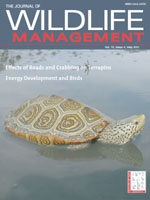Assessing wildlife management action requires monitoring populations, and abundance often is the parameter monitored. Recent methodological advances have enabled estimation of mean abundance within a habitat using presence—absence or count data obtained via repeated visits to a sample of sites. These methods assume populations are closed and intuitively assume habitats within sites change little during a field season. However, many habitats are highly variable over short periods. We developed a variation of existing occupancy and abundance models that allows for extreme spatio-temporal differences in habitat, and resulting changes in wildlife abundance, among sites and among visits to a site within a field season. We conducted our study in sugarcane habitat within the Everglades Agricultural Area southeast of Lake Okeechobee in south Florida. We counted wintering birds, primarily passerines, within 245 sites usually 5 times at each site during December 2006—March 2007. We estimated occupancy and mean abundance of birds in 6 vegetation states during the sugarcane harvest and allowed these parameters to vary temporally or spatially within a vegetation state. Occupancy and mean abundance of the common yellowthroat (Geothlypis trichas) was affected by structure of sugarcane and uncultivated edge vegetation (occupancy = 1.00 [95% C = 0.96–1.00] and mean abundance = 7.9 [95% C
= 0.96–1.00] and mean abundance = 7.9 [95% C = 3.2–19.5] in tall sugarcane with tall edge vegetation versus 0.20 [95% C
= 3.2–19.5] in tall sugarcane with tall edge vegetation versus 0.20 [95% C = 0.04–0.71] and 0.22 [95% C
= 0.04–0.71] and 0.22 [95% C = 0.04–1.2], respectively, in short sugarcane with short edge vegetation in one half of the study area). Occupancy and mean abundance of palm warblers (Dendroica palmarum) were constant (occupancy = 1.00, 95% CI = 0.69–1.00; mean abundance = 18, 95% C
= 0.04–1.2], respectively, in short sugarcane with short edge vegetation in one half of the study area). Occupancy and mean abundance of palm warblers (Dendroica palmarum) were constant (occupancy = 1.00, 95% CI = 0.69–1.00; mean abundance = 18, 95% C = 1–270). Our model may enable wildlife managers to assess rigorously effects of future edge habitat management on avian distribution and abundance within agricultural landscapes during winter or the breeding season. The model may also help wildlife managers make similar management decisions involving other dynamic habitats such as wetlands, prairies, and even forested areas if forest management or fires occur during the field season.
= 1–270). Our model may enable wildlife managers to assess rigorously effects of future edge habitat management on avian distribution and abundance within agricultural landscapes during winter or the breeding season. The model may also help wildlife managers make similar management decisions involving other dynamic habitats such as wetlands, prairies, and even forested areas if forest management or fires occur during the field season.
How to translate text using browser tools
1 May 2011
Occupancy and Abundance of Wintering Birds in a Dynamic Agricultural Landscape
Mark W. Miller,
Elise V. Pearlstine,
Robert M. Dorazio,
Frank J. Mazzotti
ACCESS THE FULL ARTICLE
It is not available for individual sale.
This article is only available to subscribers.
It is not available for individual sale.
It is not available for individual sale.

Journal of Wildlife Management
Vol. 75 • No. 4
May 2011
Vol. 75 • No. 4
May 2011
Common Yellowthroat
edge effects
Everglades Agricultural Area
palm warbler
point counts
site occupancy
sugarcane




